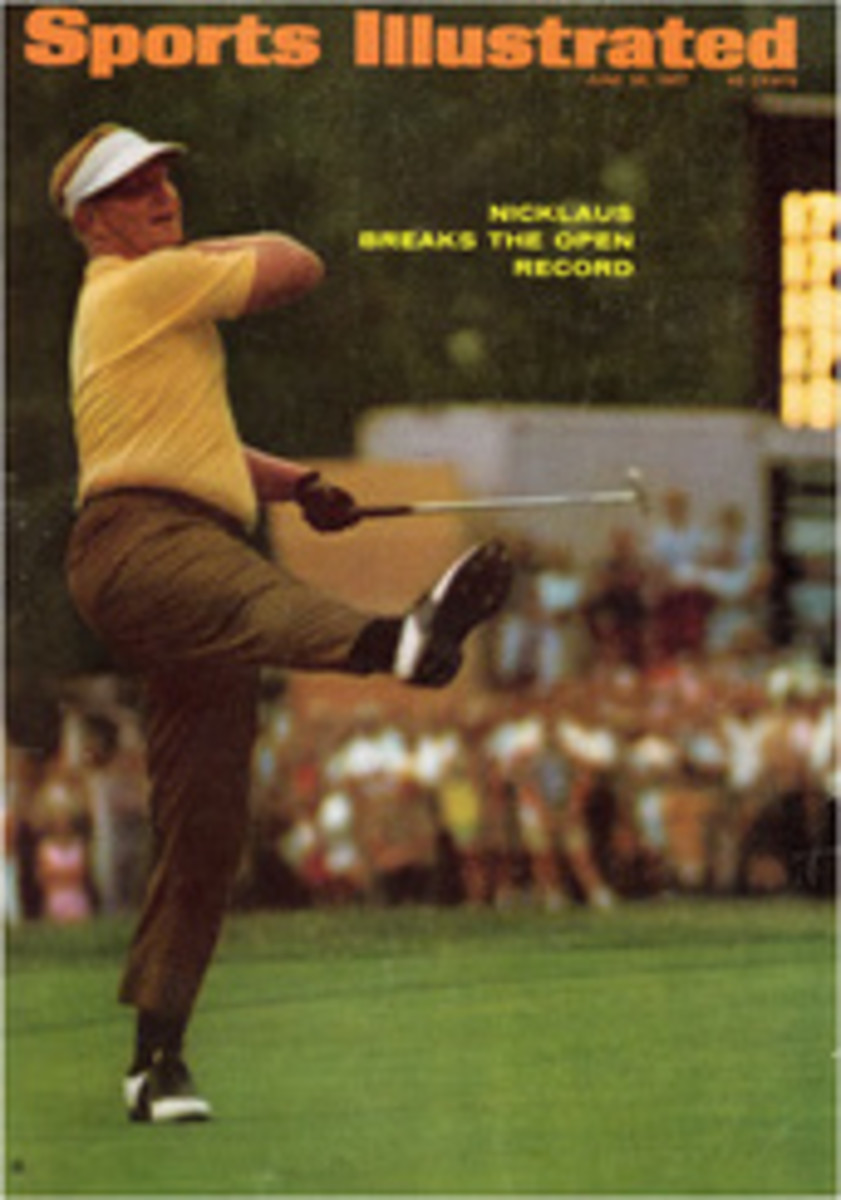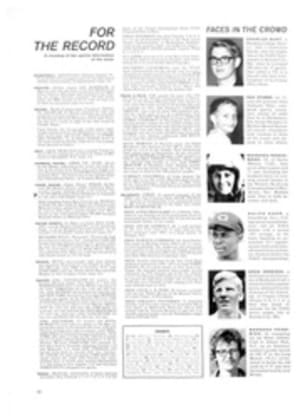
THEY'RE STILL AT IT IN INDIANA
In Indiana, almost everybody knows by now, the basketball season does not end in March, as it does elsewhere. Indeed, nothing really important happens in the sport until June, when Hoosiers from Elkhart to Evansville get the opportunity to prove theirs is the best basketball state in the Republic. From 1940 to 1955 there was little reason to dispute the claim as Indiana consistently defeated the second best state, Kentucky, in the annual high school All-Star games.
Then strange things began to happen. Kentucky, struggling for its reputation, got rid of its college coaches—who had tended to turn the game into a showcase for the players they had recruited for their own schools—and at the same time began playing Negroes. Soon, Kentucky was holding its own. In 1965 and 1966 Kentucky won four straight games. (There are two each June.) So Indiana turned around and made some changes of its own. Instead of picking its All-Stars by statewide vote of sportswriters and broadcasters, a blue-ribbon panel of 15, headed by Indiana's game director, Fred Corts, and Coach Cleon Reynolds, hand-picked the squad. The panel made sure there were no oddball characters included like Marv Winkler (SI, June 27, 1966) to complicate the task. And when the team assembled on June 7 in Indianapolis the coaches isolated the players from the inevitable tumult and shouting and extracurricular stuffing at dairy bars.
Kentucky, still trailing in the series 23 games to 14, wasn't about to take matters lightly, however. In Louisville, Coach Don Morris held secret practice sessions, made sure everybody up north knew that his Jim McDaniels was an honest 7 feet tall ("He's really only 6'11¾" barefoot," Morris later admitted) and brought along three assistants, one to help coach and two to chart everything from defensive rebounds to the number of times a Kentucky player visited the water cooler.
McDaniels, probably the best high school player in the country, was the main attraction in both camps, although only one or two Indiana players had seen him before last week. Kentucky used him as its chief weapon in the pregame psychological warfare. His statistics, 38.6 points and 25 rebounds per game, plus that elongated frame, seven inches of which he had acquired in the past 24 months, were frightening enough. But there was more, much more.
"I must have received 300 clippings on that boy since December," Indiana's Reynolds said. Fourteen of the best were tacked on the wall of the Indiana Central College gym, where the Hoosiers worked out, with phrases like "best player in the country" and "unstoppable" underlined in blood-red ink. And the final touch was a rumor spread by Kentuckians that the Boston Celtics had offered McDaniels a $100,000 bonus to turn pro right now, maybe because he had grown himself a Bill Russell goatee.
There were other Kentuckians, of course, especially Clarence Glover, a 6'8" center who was beating McDaniels consistently in practice, and Jim Rose, a four-time all-stater. Both of them, like McDaniels, will play for Western Kentucky starting this fall. In fact, of the 11 Kentucky All-Stars, five signed with Western's Johnny Oldham, and as a final affront to the University of Kentucky's Adolph Rupp, who once had a corner on everybody in the Bluegrass, even the team manager is going to Western.
To counter McDaniels' scary reputation, Reynolds first saw to it that three centers were named to his All-Stars instead of the expected two. "I'm afraid he'll run over our first two boys," he said. Then he signed on Hallie Bryant as an assistant and made Gregg Northing-ton, a 6'10½" center, Bryant's special project. Bryant was "Mr. Basketball" in Indiana in 1953 and has been with the Harlem Globetrotters for eight years. A week before the Hoosier team assembled he began working on Northington, trying to instill in him the idea he could hold his own with McDaniels. It wasn't an easy job, but Bryant had an advantage over a lot of other people. He attended Crispus Attucks High School in Indianapolis, Northington attended Wood and both are located in Negro ghettos. Bryant could at least talk to Northington, by nature a reticent kid. "Don't let that fool you," Bryant said. "Basketball's the only thing Gregg's ever had. When you grow up in a place like he did, you learn to shield yourself."
It seemed obvious that if Indiana was to have any chance at all, it depended on Northington's ability to do something with McDaniels. With Bryant's help, Northington quietly got ready, and the night before the game he even showed a bit of emotion. When McDaniels was introduced at a banquet Northington looked up and bit his ever-present toothpick in half.
Reynolds, though, wasn't convinced. "If you've got a 6'10" boy you've got to use him," he said. "He doesn't do you any good sitting on the bench. But, man, he didn't learn anything in high school. All he did there was stand around with his hands in the air. When he jumps he doesn't get more than an inch off the ground. When you don't jump against somebody like McDaniels you eat leather. I just hope McDaniels has a bad night and we can hold him to 28 points or so and stop the rest of 'em."
McDaniels, meanwhile, took all the uproar he had caused with admirable calm. The night before the game he told Kentucky's Morris, "If you want to use me as a decoy it's all right. I'll go scoreless if it will help us beat Indiana."
McDaniels almost did go scoreless. The 14,565 fans who jammed themselves inside Butler University's Hinkle Field-house waving scorecard-fans like a convention of butterflies to combat the end of a massive Midwest heat wave expected to see the traditional duel of the big men. McDaniels and Northington definitely had a duel, but it wasn't very traditional, and it was not at all what anyone expected.
They were matched up all right—the man-to-man defenses employed by both teams saw to that—but instead of a high-scoring, high-rebounding free-for-all, what took place was more like a street brawl. When they were on the court together they spent their time clawing and scratching at each other with complete disdain for the rule book. It got so bad that at one point the referees had to warn them to cut out the wrestling.
The game itself was a bit of an anticlimax. Both teams were obviously tense and nervous and their play reflected it. Kentucky shot just 40% from the floor and Indiana was worse with 32%. More important, while McDaniels and Northington carried on their own private war, Kentucky came up with two little men, Rose and Glenn Montgomery, 6'3" and 6'1" respectively, who hit superbly from the outside and threatened several times to make a rout of the whole affair. Rose, working from the left side, shot consistently while the defense sagged. He utilized his picks and screens well or drove the base line himself and finished the game as high scorer with 25 points to lead Kentucky's decisive 79-67 win. Kentucky never trailed after a three-point play by Rose put it ahead early in the first half.
Until the last seven minutes, in fact, no big man really distinguished himself. Glover fouled out with 14 minutes remaining and just two points to his credit; McDaniels followed seven minutes later with two field goals and seven points after sitting out most of the second half because he had four fouls. With those two out of the way, Northington finally went to work offensively. In the space of five minutes he hit five field goals in seven attempts and nearly rallied Indiana to a victory all by himself. Twice the Hoosiers came to within six points in the final minutes after trailing by as many as 14 early in the half, but on both occasions Rose or Montgomery or somebody picked up a field goal here, a three-point play there, to keep Indiana dangling.
Before the game Reynolds, who was twice the losing coach in 1966, had said, "If we don't win Saturday there may be a rope hanging from the top of the field house after the game—with me at the end of it."
That, of course, didn't happen, but this Saturday it's a good bet Reynolds will cast a wary eye toward the rafters of Louisville's Freedom Hall when the second game begins.
PHOTO
Shooting from one of his pet positions, Kentucky's Jim Rose gets two of the 25 points that made him the All-Star game's high scorer.

